Human Orbital Spaceflights
![]()
International Flight No. 56Soyuz 21BaikalUSSR |
 |
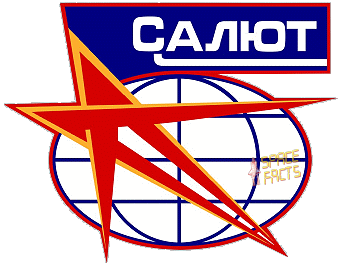 |
![]()
Launch, orbit and landing data
walkout photo |
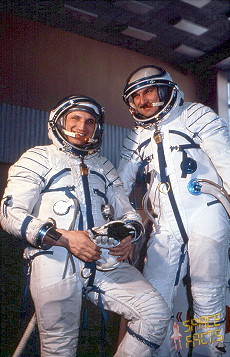 |
|||||||||||||||||||||||
alternative crew photo |
alternative crew photo |
|||||||||||||||||||||||
alternative crew photo |
alternative crew photo |
|||||||||||||||||||||||
alternative crew photo |
alternative crew photo |
|||||||||||||||||||||||
Crew
| No. | Surname | Given names | Position | Flight No. | Duration | Orbits | |
| 1 | Volynov | Boris Valentinovich | Commander | 2 | 49d 06h 23m 32s | 791 | |
| 2 | Zholobov | Vitali Mikhailovich | Flight Engineer | 1 | 49d 06h 23m 32s | 791 |
Crew seating arrangement
|
 |
|
||||||||||||
1st Backup Crew
|
 |
|||||||||||||||
2nd Backup Crew
|
 |
|||||||||||||||
Hardware
| Launch vehicle: | Soyuz (No. F15000-34) |
| Spacecraft: | Soyuz 21 (7K-T No. 41) |
Flight
|
Launch from the Baikonur Cosmodrome and
landing 200 km southwest of Kokchetav. Following a one-day solo flight Soyuz 21 docked with Salyut 5 on July 07, 1976. The spacecraft with Boris Volynov and Vitali Zholobov aboard hard-docked with the station on July 06, 1976 after a failure of the Igla system at the last stage of the rendezvous. Their stay coincided with the start of the Siber military exercise in Siberia, which they observed as part of an assessment of the station’s military surveillance capabilities. They conducted only a few scientific experiments, including the first use of the Kristall furnace for crystal growth. Engineering experiments included propellant transfer system tests with implications for future operation of the freight-carrying Progress spacecraft. Observation of aquarium fishes in the microgravity was done too. Solar observation and biological observation (plant growing) were carried out. The Kalialaun-experiment was needed for the observation of crystal grooving in space. Also, a TV conference with pupils was held. Towards the end of the two months mission an early return to earth was requested due to the poor condition of Flight Engineer Vitali Zholobov (who was suffering from space sickness and psychological problems). The crew landed in very bad physical and mental condition. Vitali Zholobov's illness was apparently caused by nitric acid fumes leaking from the Salyut's propellant tanks; other reports, however, indicate that the crew failed to follow their physical exercise program and suffered from lack of sleep. Sources at NASA have reported that psychologists with the Russian Aviation and Space Agency cited Soyuz 21 as ending prematurely due to unspecified "interpersonal issues" with the crew. The next mission to successfully dock with the station, Soyuz 24, would vent Salyut 5's air to space and replace it due to concerns the air had become toxic. The cosmonauts boarded Soyuz 21 but as Boris Volynov tried to undock from the station, the docking latches failed to release properly. As he fired the jets to move the spacecraft away, the docking mechanism jammed, resulting in the Soyuz being undocked but still linked to Salyut. As the two spacecraft moved out of range of ground communications, the cosmonauts received only the first set of emergency procedures. Boris Volynov tried a second time to undock but only managed slightly to loosen the latches. The situation persisted for an entire orbit, 90 minutes, when the final set of emergency procedures were received and the crew finally disengaged the latches. The Soyuz spacecraft is composed of three elements attached end-to-end - the Orbital Module, the Descent Module and the Instrumentation/Propulsion Module. The crew occupied the central element, the Descent Module. The other two modules are jettisoned prior to re-entry. They burn up in the atmosphere, so only the Descent Module returned to Earth. The deorbit burn lasted 188 seconds. Having shed two-thirds of its mass, the Soyuz reached Entry Interface - a point 400,000 feet (121.9 kilometers) above the Earth, where friction due to the thickening atmosphere began to heat its outer surfaces. With only 23 minutes left before it lands on the grassy plains of central Asia, attention in the module turned to slowing its rate of descent. Eight minutes later, the spacecraft was streaking through the sky at a rate of 755 feet (230 meters) per second. Before it touched down, its speed slowed to only 5 feet (1.5 meter) per second, and it lands at an even lower speed than that. Several onboard features ensure that the vehicle and crew land safely and in relative comfort. Four parachutes, deployed 15 minutes before landing, dramatically slowed the vehicle's rate of descent. Two pilot parachutes were the first to be released, and a drogue chute attached to the second one followed immediately after. The drogue, measuring 24 square meters (258 square feet) in area, slowed the rate of descent from 755 feet (230 meters) per second to 262 feet (80 meters) per second. The main parachute was the last to emerge. It is the largest chute, with a surface area of 10,764 square feet (1,000 square meters). Its harnesses shifted the vehicle's attitude to a 30-degree angle relative to the ground, dissipating heat, and then shifted it again to a straight vertical descent prior to landing. The main chute slowed the Soyuz to a descent rate of only 24 feet (7.3 meters) per second, which is still too fast for a comfortable landing. One second before touchdown, two sets of three small engines on the bottom of the vehicle fired, slowing the vehicle to soften the landing. Because Soyuz 21 was returning early, it was outside the normal recovery window. It then encountered strong winds as it descended, which caused uneven firing of the retrorockets. It made a hard landing around midnight. |
Photos / Graphics
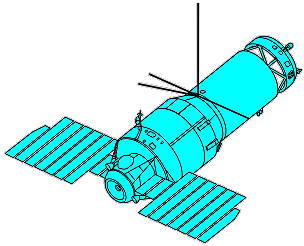 |
 |
 |
 |
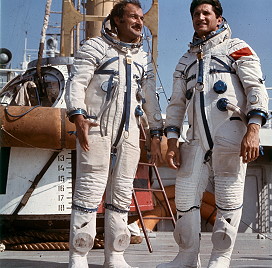 |
 |
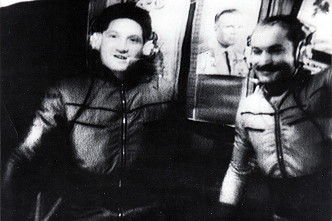 |
 |
| © |  |
Last update on March 28, 2020.  |
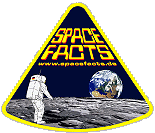 |